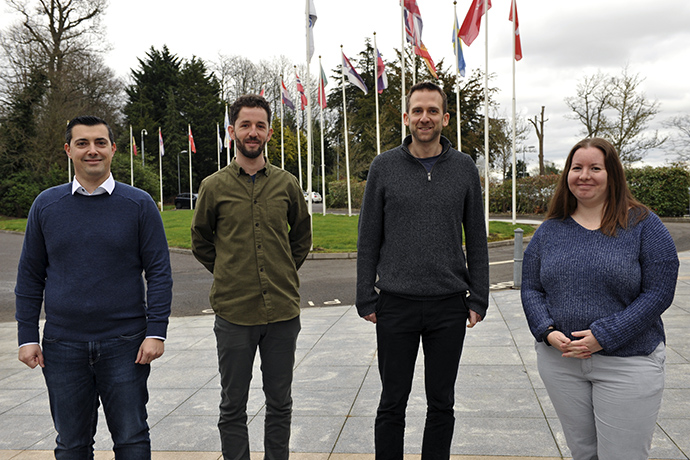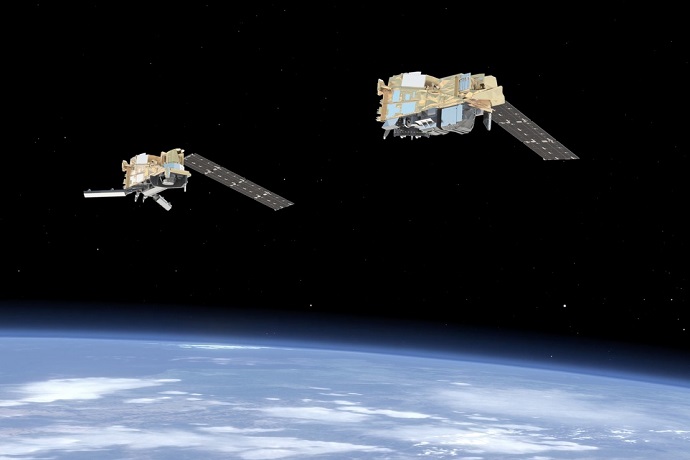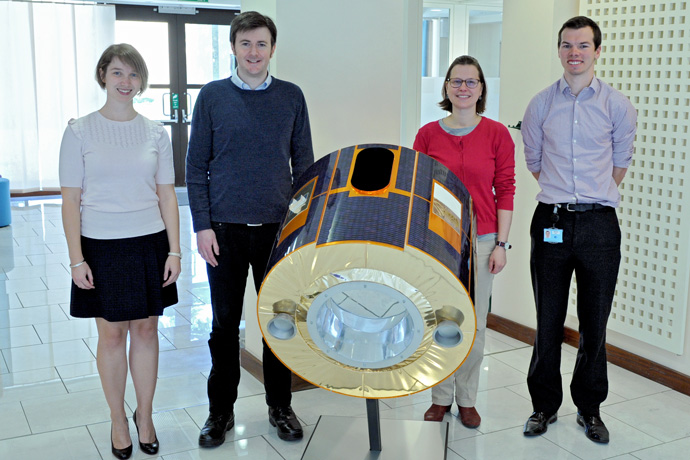

The four EUMETSAT Research Fellows who are currently at ECMWF are (left to right) Samuel Quesada-Ruiz, David Duncan, Francis Warrick and Tracy Scanlon.
Four EUMETSAT Research Fellows are helping ECMWF to fully exploit satellite data for weather forecasting. The data is needed to help establish the initial conditions of forecasts as precisely as possible.
Satellite data make a crucial contribution to establishing those conditions in a process called data assimilation. That is why ECMWF and EUMETSAT cooperate closely on the kinds of satellite data that are needed for weather forecasting.
The work of the EUMETSAT Research Fellows covers many of the large range of instruments on geostationary and polar-orbiting satellites that contribute to data assimilation at ECMWF.
“EUMETSAT, in close partnership with Member States, supports young scientists in developing new uses and applications of EUMETSAT satellite data,” says EUMETSAT Chief Scientist Paolo Ruti. “These Fellows work in research and operational host institutions from across Europe, and they are a key asset for EUMETSAT and Member States. Through this programme we entrain talented early career scientists into our operational environment.”
Microwave imagers
Tracy Scanlon joined ECMWF in September 2021 on a five-year Fellowship. She is working on the all-sky assimilation of radiances recorded by microwave imagers.
These instruments provide information on water vapour, cloud and precipitation, particularly in the lowermost troposphere. They are carried by polar-orbiting satellites and the radiances they measure are prominent targets in ECMWF’s all-sky/all-surface strategy.
“I've been working on including new data in ECMWF’s Integrated Forecasting System,” Tracy says. “These are from the Special Sensor Microwave Imager Sounder (SSMIS) on board the US Defense Meteorological Satellite Program-F18 (DMSP-F18).”
Tracy is also looking to improve the ‘forward operator’, in other words simulated values that can be compared directly with observations, in convective cloud situations.
“Other work I will undertake during my fellowship includes preparation for new imagers on board the second generation of EUMETSAT’s polar-orbiting Metop satellites (EPS-SG), which are expected to go into orbit from 2023.”

Artist’s impression of Metop-SG A (foreground) and Metop-SG B satellites in orbit. (Copyright: EUMETSAT)
Geostationary infrared radiances
Samuel Quesada-Ruiz started a three-year Fellowship at ECMWF in October 2020. He works on the assimilation of infrared radiances from geostationary satellites. They mainly provide information about atmospheric water vapour content and temperature.
Last year, Samuel worked on adding the GOES-17 satellite to the GOES-16, Meteosat-11, Meteosat-8 and Himawari-8 satellites. In liaison with the US National Oceanic and Atmospheric Administration (NOAA), he adapted the code of ECMWF’s Integrated Forecasting System to be able to ingest a newer version of the GOES-16/-17 radiance product.
He also identified an issue with the Meteosat-11 and -8 radiance product, which was reported to EUMETSAT. They implemented corresponding changes, and the result was an improved radiance product, a gain of one hour of data per day and a correction of the observation timing.
On the research side, Samuel’s focus has been on investigating further use of the geostationary infrared information over the ocean. Currently only radiances from the water vapour channels are actively assimilated, with those from the window channel used as an additional quality control check for cloud contamination. However, the window channel is the only source of information to constrain the full diurnal cycle of the skin temperature.
“My plan for this year is to start working with colleagues in ECMWF’s modelling section to improve the balance between the observed and modelled values,” Samuel says. “This will allow the active assimilation of the geostationary window channels providing information on sea-surface temperature.”

Data coverage for geostationary radiances used at ECMWF from 21 UTC on 8 February 2022 to 3 UTC on 9 February 2022.
Atmospheric Motion Vectors
Francis Warrick joined ECMWF in October 2020 on a five-year Fellowship. His focus is on improving the use of Atmospheric Motion Vectors (AMVs).
AMVs provide information on winds around the world by tracking cloud or water vapour features through a series of satellite images. ECMWF currently uses AMVs from five geostationary and nine polar-orbiting satellites.
“So far in my fellowship I have overseen some operational changes in the satellites and data format used in our AMV assimilation,” Francis says. “I have also been running assimilation experiments to test the forecast impact of AMV data that combines images from multiple satellites, and the forecast impact of a new version of the GOES AMVs we receive from NOAA.”
One theme for the remainder of the fellowship will be the comparison of AMVs to data from the Aeolus satellite. Aeolus is carrying the world’s first functioning space-based Doppler wind lidar. It provides a new way of assessing the AMVs' quality.
The plot shows the Aeolus Level-2B Rayleigh-clear and Mie-cloudy horizontal line-of-sight wind speed profiles on 14 February 2020 over the North Atlantic. The blue area highlights the location of a jet streak with wind speeds up to about 100 m/s.
Francis will also make use of the cloud physics information available from the AMVs. It is hoped that this information will enable us to make smarter decisions about which AMVs to assimilate and what errors to assign to them.
Microwave sounders
David Duncan joined ECMWF in May 2019 on a three-year Fellowship. His responsibility is for microwave sounders. These satellite instruments are installed on polar-orbiting satellites and provide profile information on temperature and moisture.
“We showed in a 2021 paper that sounders rank among the most impactful observations used in global numerical weather prediction,” David says. “We demonstrated that forecasts improve dramatically with the first sounders assimilated and continue to improve with more sounders added.”
Part of his job is to maintain the optimal usage of these sensors in the operational system.

Change in geopotential height root-mean-square error (RMSE) at 500 hPa as a result of adding various numbers of sounders, given as a percentage difference relative to ‘no sounders’ as the control, for the southern hemisphere (20°–90°S) and the northern hemisphere (20°–90°N). The black lines indicate 95% confidence intervals. From the Quarterly Journal of the Royal Meteorological Society.
David has also moved the AMSU-A microwave sounder to all-sky assimilation. This has increased data assimilation in cloudy regions and improved the observation capability for severe events, such as tropical cyclones.
One of David’s objectives for the end of his fellowship is to assess the sounders and the importance of the unique orbit of a Chinese satellite, FY-3E, that launched last year. “This is a nice bookend to the fellowship as I put its predecessor, FY-3D, into the operational system back in December 2019.”
Previous EUMETSAT Research Fellows
The current four Fellows have been preceded by four others, who say they have gained a lot during their time as EUMETSAT Research Fellows.

Previous EUMESAT Research Fellows were (left to right) Katie Lean, Chris Burrows, Katrin Lonitz and Peter Weston.
Katie Lean says her Fellowship provided valuable experience in both operational implementation and AMV research activities. “Along with acquiring specialist knowledge, the Fellowship gave me the opportunity to improve technical and communication skills and to be exposed to a wide range of research topics.”
Chris Burrows found that his Fellowship enabled him to develop his skills in geostationary satellite data assimilation. “It was stimulating being at the interface between EUMETSAT and ECMWF and contributing to ECMWF operational upgrades, which improved the forecast skill through improved use of geostationary radiance data from EUMETSAT.”
Katrin Lonitz, who worked on the improvement of the all-sky assimilation of microwave radiances, emphasises the ‘open-door policy’ at ECMWF. “Besides working on the IFS code and on operational changes, I truly enjoyed the discussion about our work with my colleagues. The open-door policy really made it easy to ask questions and to get to talk to the experts.”
And Peter Weston found that he was immersed in challenging and cutting-edge research. “The Fellowship gave me responsibility for maintaining parts of the NWP system and I learnt how to effectively balance long-term research goals with short-term operational changes. I also presented my work at international conferences and contributed to journal articles and scientific reports.”
